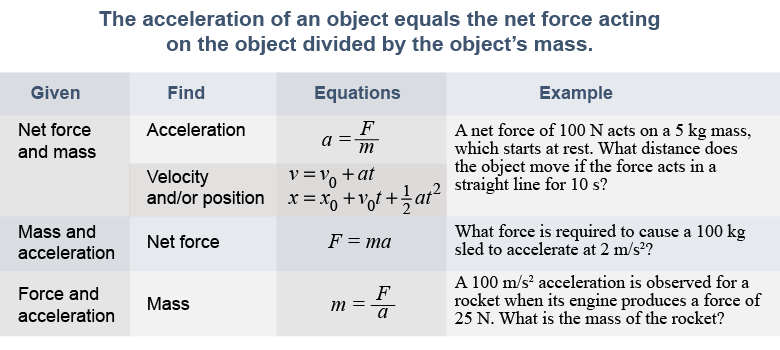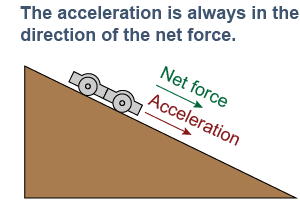|
Newton’s second law of motion is probably the most widely used equation in all of physics. It says that the acceleration of an object is equal to the force you apply divided by the mass of the object. If you apply more force to an object, it accelerates at a higher rate. For a given force, an object with more mass will accelerate less. If the net force is zero then the acceleration is also zero, which means no change in speed or direction. The first law is therefore a special case of the second law, when a = 0. 
|
| (5.3) | | | F | = | net force (N) | | m | = | mass (kg) | | a | = | acceleration (m/s2) |
| Newton’s second law
|
|

|
The three forms of the second law shown in the table above are each convenient for finding a different quantity. Note that the equations of motion are also included in the first row. In many problems you want to know the position and/or speed of an object given a force acting over some interval of time. To solve these problems the second law is used to find the acceleration, which is then used to determine the speed and position. 
|
As with all equations, units must be consistent. One newton equals one kilogram times one meter per second per second (m/s2). When using the second law you must be sure to convert all information into consistent units. Speeds must be converted to meters per second. Masses in grams should be converted to kilograms and forces in pounds should be converted to newtons. 
|

- Always remember that the F appearing in the second law is the net force.
- The second law is a vector relationship and the direction of acceleration a is the same as the direction of the net force F.
- If the motion is constrained, such as along a ramp, then the net force will always be along the allowed direction of motion.

|
Simone is pushing a frictionless cart with a mass of 25 kg. She pushes with a force of 100 N. What is the acceleration of the cart? - 0.25 m/s2
- 0.4 m/s2
- 4 m/s2
- 2,500 m/s2
 |
The answer is c, 4 m/s2. Use Newton’s second law, a = F/m. 
|

